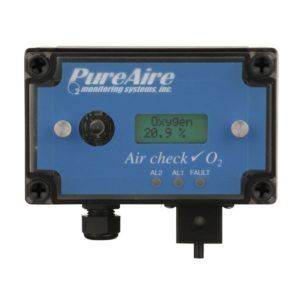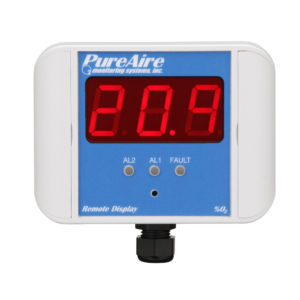What is an Oxygen Deficiency Monitor?
- By : PureAire Monitoring Systems
- Posted on : March 15, 2024
- News Room
Understanding Oxygen Deficiency
The air we breathe is made up of 78% nitrogen, 21% oxygen, and trace amounts of other gases such as carbon dioxide, neon, and hydrogen. The oxygen level in the air we breathe is approximately 20.9%. A drop in oxygen levels below this percentage indicates an oxygen-depleted environment that poses significant health and safety risks. Oxygen depletion occurs when oxygen is displaced by inert gases including, but not limited to, nitrogen, argon, helium, or carbon dioxide. An oxygen-deficient environment can occur in various settings, such as enclosed rooms or industrial spaces, where ventilation is inadequate, inert gases are used, stored, or may accumulate, or when oxygen consumption is unusually high.
The primary danger of oxygen depletion is the onset of hypoxia, a condition characterized by an inadequate supply of oxygen in the body or a specific area of the body. Hypoxia can lead to severe health impacts, including:
- Cognitive impairment: Reduced mental alertness, impaired coordination, and decreased decision-making ability.
- Physical symptoms: Breathing difficulties, rapid heartbeat, poor color vision, and fatigue.
- Severe health complications: Unconsciousness, coma, and even death in extreme cases.
Detecting these changes promptly and accurately is crucial for mitigating potential hazards associated with oxygen-depleted environments. Knowing the health risks of oxygen depletion is vital to understanding the importance of installing oxygen deficiency monitors.
Types of Oxygen Depletion Sensors
Oxygen deficiency sensors are crucial in protecting individuals from the dangers associated with low-oxygen environments. The sensors continuously monitor oxygen levels and provide accurate O2 measurements. Oxygen sensors use different technologies to detect the concentration of oxygen, including:
- Electrochemical sensors react with oxygen in the environment. A reduction-oxidation reaction generates a current proportional to the concentration of oxygen, which the monitor interprets to determine whether levels are within safe limits. Electrochemical sensors deplete over time, eventually leading to sensor failure, and often display sensitivity to variations in pressure, temperature, or relative humidity, which can distort their readings and compromise accuracy.
- Zirconia-based oxygen sensors operate using Yttria-Stabilized Zirconia (YSZ), a solid-state ionic ceramic with unique oxygen-ion conductivity properties that are ideal for oxygen sensing. At an operational temperature of 450°C, YSZ becomes a highly effective oxygen ion conductor, with oxygen molecules transferring electrons between platinum electrodes through the YSZ, generating an electric current indicative of oxygen concentration. Unlike traditional electrochemical cells, YSZ sensors do not deplete over time, offering a longer lifespan and greater reliability in diverse environments without being affected by variations in pressure, temperature, or humidity. Their non-depleting nature, resilience to environmental changes, and minimal recalibration needs make YSZ sensors a superior choice for long-term, reliable oxygen monitoring in industrial and laboratory settings.
The Benefits of Oxygen Depletion Monitors
Oxygen depletion monitors offer several significant advantages:
- Continuous Monitoring: These sensors quickly identify a drop in normal oxygen levels by constantly measuring the surrounding air.
- Accurate Data: Oxygen depletion sensors deliver precise data, crucial for maintaining safety standards in enclosed spaces where oxygen levels may vary.
- Early Warning System: A drop in oxygen levels will trigger the system, which detects even slight changes in oxygen levels and triggers appropriate responses to prevent hazardous conditions.
- Integration with Safety Measures: O2 deficiency monitors can activate alarms, including lights and horns, or initiate ventilation procedures to keep personnel safe.
Oxygen deficiency monitors are essential to maintaining environmental safety by measuring oxygen levels within an enclosed space.
Industries that rely on Oxygen Depletion Sensors
Oxygen depletion sensors are essential in a wide variety of industrial and commercial settings where the control of environmental conditions is critical, including:
- Laboratories
- Pharmaceutical
- Food and Beverage
- Additive Manufacturing
- Manufacturing facilities
- Storage areas for cryogenics materials
- Confined spaces such as tanks or silos
Compliance with Regulatory Standards (OSHA)
The Occupational Safety and Health Administration (OSHA) enforces stringent regulatory requirements for O2 deficiency monitors to protect workers in various industrial settings. These standards are designed to prevent accidents associated with oxygen depletion, which can have dire consequences for human health and operational integrity.
OSHA Guidelines for Oxygen Levels:
- Minimum Oxygen Concentration: OSHA standard 29 CFR 1920.146 delineates that the permissible oxygen concentration in an occupational setting should not fall below 19.5 percent by volume.
- Hazardous Atmosphere Prevention: Workplaces identified as confined spaces, locations, or operations that consume or displace oxygen must be equipped with reliable oxygen deficiency monitoring solutions. 1910.146, Appendix B
- Monitoring Requirements: Continuous monitoring is mandated in environments where oxygen levels may fluctuate unpredictably due to processes such as combustion, chemical reactions, or biological activity. 1910.146(d)(5)(ii)
Compliance with these regulations is not solely a matter of legal adherence but serves to uphold worker safety.
PureAire Oxygen Deficiency Monitors
PureAire Monitoring Systems’ line of Oxygen Deficiency Monitors offers thorough air monitoring, with no time-consuming maintenance or calibration required. An easy-to-read screen displays current oxygen levels for at-a-glance reading by employees, who derive peace of mind from the Monitor’s presence and reliable performance.
Our Monitor continuously tracks oxygen levels and, in the event of a gas leak and a drop in oxygen to an OSHA action level, will set off an alarm, complete with horns and flashing lights, alerting employees to evacuate the affected area.
The Monitor will remain accurate at temperatures as low as -40C. PureAire’s durable, non-depleting, long-life zirconium oxide sensor will last for 10+ years in a normal environment without needing to be replaced.
To reduce risk to personnel, PureAire’s optional Remote Digital Display may be placed well outside of high-risk rooms (up to 250 feet from the Monitor itself), where it will safely exhibit oxygen levels inside the room.




